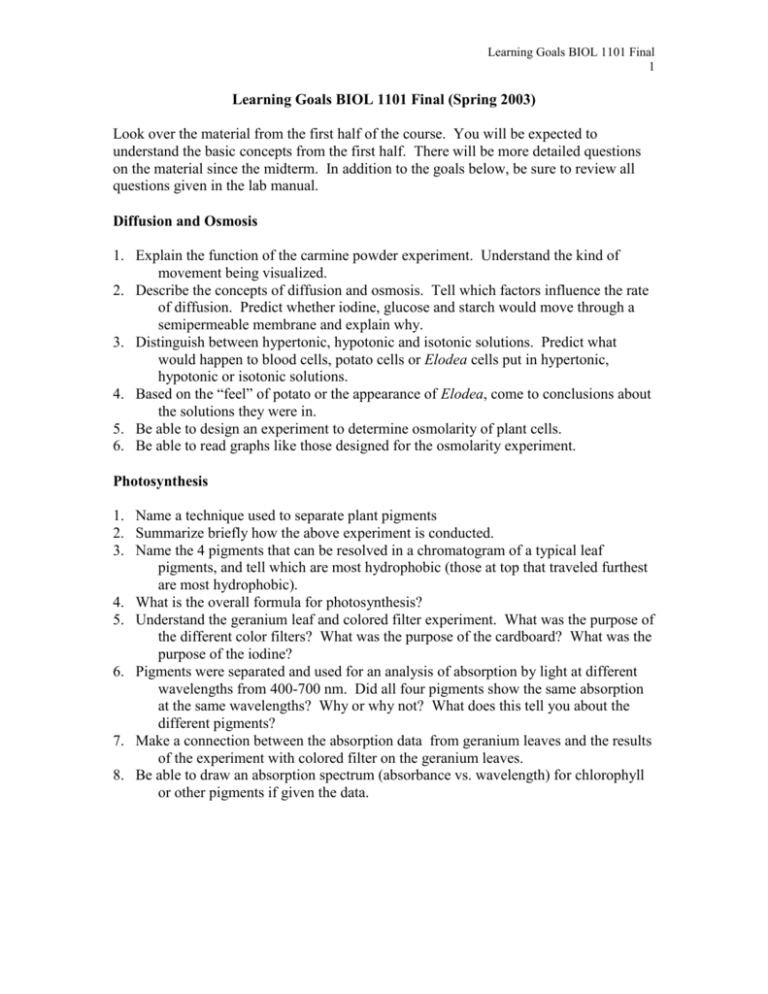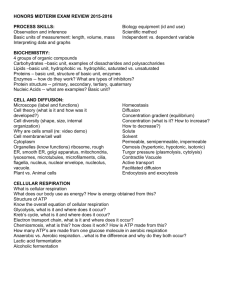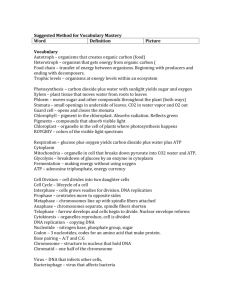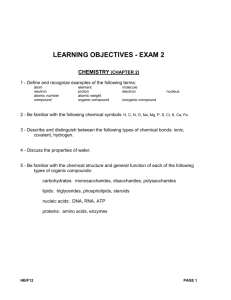Review for Final Exam
advertisement

Learning Goals BIOL 1101 Final 1 Learning Goals BIOL 1101 Final (Spring 2003) Look over the material from the first half of the course. You will be expected to understand the basic concepts from the first half. There will be more detailed questions on the material since the midterm. In addition to the goals below, be sure to review all questions given in the lab manual. Diffusion and Osmosis 1. Explain the function of the carmine powder experiment. Understand the kind of movement being visualized. 2. Describe the concepts of diffusion and osmosis. Tell which factors influence the rate of diffusion. Predict whether iodine, glucose and starch would move through a semipermeable membrane and explain why. 3. Distinguish between hypertonic, hypotonic and isotonic solutions. Predict what would happen to blood cells, potato cells or Elodea cells put in hypertonic, hypotonic or isotonic solutions. 4. Based on the “feel” of potato or the appearance of Elodea, come to conclusions about the solutions they were in. 5. Be able to design an experiment to determine osmolarity of plant cells. 6. Be able to read graphs like those designed for the osmolarity experiment. Photosynthesis 1. Name a technique used to separate plant pigments 2. Summarize briefly how the above experiment is conducted. 3. Name the 4 pigments that can be resolved in a chromatogram of a typical leaf pigments, and tell which are most hydrophobic (those at top that traveled furthest are most hydrophobic). 4. What is the overall formula for photosynthesis? 5. Understand the geranium leaf and colored filter experiment. What was the purpose of the different color filters? What was the purpose of the cardboard? What was the purpose of the iodine? 6. Pigments were separated and used for an analysis of absorption by light at different wavelengths from 400-700 nm. Did all four pigments show the same absorption at the same wavelengths? Why or why not? What does this tell you about the different pigments? 7. Make a connection between the absorption data from geranium leaves and the results of the experiment with colored filter on the geranium leaves. 8. Be able to draw an absorption spectrum (absorbance vs. wavelength) for chlorophyll or other pigments if given the data. Learning Goals BIOL 1101 Final 2 Respiration 1. Know the formula for respiration and be able to explain the purpose of respiration. 2. Understand what phenol red is and be able to describe its role in the respiration experiment. 3. Describe how the rate of respiration is being measured in bean/seed respiration experiment (Which parameter is being measured?). 4. Understand the function of fermentation for cells and be able to explain a simple fermentation experiment (Which parameter will be measured?). 5. Know the fermentation end product for human muscle cells and yeast cells. 6. Be able to design a respiration or fermentation experiment complete with controls. Mitosis and Meiosis Recognize a slide of whitefish blastula or onion root tip, and tell why these are good sources for mitotic cells. 2. Recognize whether a blastula cell or onion root tip cell is in interphase, prophase, metaphase, anaphase or telophase and tell how you know. 3. Tell whether any blastula or onion cell shown is haploid or diploid and whether each chromosome contains one chromatid or two. In other words, are the chromosomes at that phase duplicated or unduplicated? 4. In the blastula cell identify the spindle fibers, the asters (bundles of microtubules), the cell membrane, or the nucleus (nucleus only visible in prophase or interphase). 5. In the onion cell identify the cell plate, the spindles, the cell membrane and the nucleus (nucleus only visible in prophase or interphase). 6. Distinguish the events of mitosis from the events of cytokinesis. 7. Cite a difference between plant and animal cell mitosis. 8. If shown a representation of mitotic chromosomes with beads, be able to: tell the stage of mitosis tell whether the cell is haploid or diploid tell the chromosome number tell whether the chromosomes are duplicated or unduplicated 9. Tell whether a specific cell type will undergo mitosis or meiosis. 10. Tell how many sperm result from spermatogenesis per 2N “pre-sperm” cell. Tell how many eggs and polar bodies result from each 2N “pre-egg” cell. 11. If shown a representation of meiosis with beads be able to: tell whether mitosis or meiosis is shown tell the stage shown, including whether it is I or II tell whether the cell is haploid or diploid tell the chromosome number name a cell type that could be in this stage tell whether the chromosomes are duplicated or unduplicated 12. Explain how independent assortment and crossing over are important to increasing variability. 13. Know when independent assortment and crossing occur. 1. Learning Goals BIOL 1101 Final 3 Regarding Genetics If given an autosomal human genetic trait such as tongue rolling (you will be told which alleles are dominant in all cases, you don't need to memorize that), be able to determine what the phenotype is and what the genotype could be for that trait. If given the genotypes of two parents, tell the possible gametes each can produce with respect to that trait, and all the possible combinations of offspring that could result from fertilization. 2. If shown offspring of a monohybrid or dihybrid cross (such as with corn), tell the phenotype and genotype of one individual and based on the data determine whether a given allele is dominant or recessive. 3. Determine the expected proportion of offspring that would result if the hypothesis were true. 4. Using chi-square analysis, determine whether a hypothesis about parental genotype is supported (bring your calculator to the exam). 1. Regarding molecular genetics 1. Be able to identify the agarose gel, wells, comb, gel box, electrophoresis buffer, light box and describe the importance of each. Describe why DNA is loaded into wells at the negative end of the gel box. (Remember “run to red.”). Know that pUC19 is plasmid DNA and know how the size of plasmid DNA compares to bacterial chromosomal DNA. 2. Understand the function of restriction enzymes and give the names of the two restriction enzymes used in class. 3. If given a restriction map indicating restriction cut sites, be able to determine how many bands of DNA should be observable on the gel. 4. If given a gel or a picture of gel be able to determine which lane represents uncut DNA and which lanes represent DNA cut with restriction enzymes. Also, be able to comment on the relative size of DNA bands based on their position in a gel compared to a known marker.








